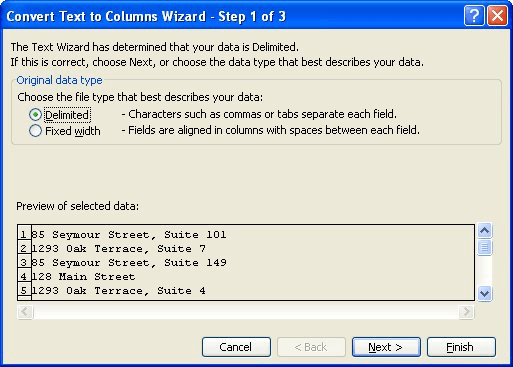Please Note: This article is written for users of the following Microsoft Excel versions: 97, 2000, 2002, and 2003. If you are using a later version (Excel 2007 or later), this tip may not work for you. For a version of this tip written specifically for later versions of Excel, click here: Converting Forced Text to Numbers.
Written by Allen Wyatt (last updated November 24, 2018)
This tip applies to Excel 97, 2000, 2002, and 2003
When you enter information in a worksheet, Excel does its best to decipher what type of data you are entering. If your entry can be translated as a number or a date, then Excel treats it that way. You can overcome this natural tendency of Excel by formatting a cell as text before entering information in it. When you do, the information in the cell is always treated as text.
Of course, forcing Excel to treat your input as text can have unwanted repercussions later. For instance, you may decide that you want to add up the contents of cells that are formatted as text. If you use a formula such as the following, then Excel has no problem:
=A1 + A2
Excel provides the correct sum, provided at least one of the cells (A1 or A2) was not formatted as text. To make matters tricky, however, if you use the SUM function (which most people do when summing an entire column or row), then you won't get the proper sum. The SUM function ignores any cells formatted as text. How do you get around this?
It is possible to remove the text formatting attribute from the cells you want to sum, but that won't cause Excel to reassess the contents of the cells and treat them as numbers or dates, where appropriate. There are several different ways you can force the conversion of forced text into numeric values, ranging from macros to using formulas in other columns to perform the conversion. The following two solutions, however, seem to be the easiest and quickest.
The first method is accomplished by following these steps:

Figure 1. The Paste Special dialog box.
This works because Excel multiples each cell in the range (step 3) by the value in the Clipboard and then again stores the value in the cell. Since any number multiplied by one is that same number, you effectively force Excel to replace the contents of the cell with the numerical equivalent of the text that was previously there.
If the range you want to convert contains only numbers formatted as text and not any actual text, then the following steps work well:

Figure 2. The Convert Text to Columns Wizard.
If you try these three steps on a range of cells that has text containing spaces or tabs, it is possible that you could overwrite data in columns to the right of the selected range. That is why it is safest to use if the range only contains numeric values formatted as text.
ExcelTips is your source for cost-effective Microsoft Excel training. This tip (2670) applies to Microsoft Excel 97, 2000, 2002, and 2003. You can find a version of this tip for the ribbon interface of Excel (Excel 2007 and later) here: Converting Forced Text to Numbers.

Excel Smarts for Beginners! Featuring the friendly and trusted For Dummies style, this popular guide shows beginners how to get up and running with Excel while also helping more experienced users get comfortable with the newest features. Check out Excel 2019 For Dummies today!
Applying different formatting to the text within a cell can seem a bit confusing. This is certainly the case when it ...
Discover MoreWant to see all the text that is in a cell, even if it is quite a bit? You need to make sure that text wrapping is turned ...
Discover MoreThis tip contains a macro to hide rows that contain data you don't want to see.
Discover MoreFREE SERVICE: Get tips like this every week in ExcelTips, a free productivity newsletter. Enter your address and click "Subscribe."
2019-11-11 09:28:59
Carl
Big thank you for this tip! You saved me a ton of time - hats off!
2019-07-17 14:43:50
Audrey Lee
Wow, thank you SO much. Exporting reports from Quickbooks Online to Excel resulted in all of the data being recognized as text. It was so frustrating, but using your "Paste Special" - "Multiply" tip worked well and saved me so much time. Thank you!
2019-07-16 14:27:36
Kevin Miller
This quick solution really bailed me out, Thank you!
2019-03-21 10:48:36
Bhupesh
Thanks Thanks Thanks!!!
2019-03-12 12:14:47
Robert Tupilo
genius - this is the only think that worked! (multiply by 1)
2019-03-05 19:34:17
jeff
literally nothing works. i've tried all these steps i cant get the error to show its not a number the text to columns does nothing, the paste special multiple does nothing...
2019-02-20 23:59:47
Nat
Thank you! This really helped...
Got a version of Excel that uses the menu interface (Excel 97, Excel 2000, Excel 2002, or Excel 2003)? This site is for you! If you use a later version of Excel, visit our ExcelTips site focusing on the ribbon interface.
FREE SERVICE: Get tips like this every week in ExcelTips, a free productivity newsletter. Enter your address and click "Subscribe."
Copyright © 2026 Sharon Parq Associates, Inc.
Comments